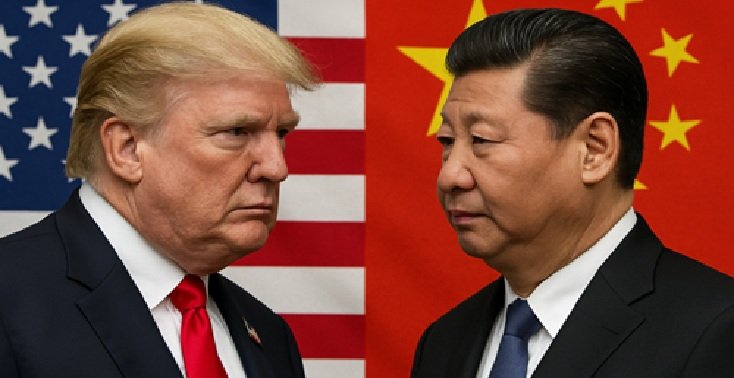-
VRIGHT Exchange | Research & Strategy Desk posted an update in the group Economy & Industry Triggers
3 weeks, 2 days agoTrillions Lost, Lessons Gained — The Story of October 11, 2025
By VRIGHT Exchange Research Desk
October 11, 2025, will be remembered as the day global financial markets hit the reset button. Within hours, trillions in market value were wiped out, leaving investors stunned and portfolios deep in the red. Yet, in this chaos lay profound lessons—about leverage, emotion, geopolitical strategy, and the timeless value of resilience.
The Great Shock: From Wall Street to Web3
The turmoil began when U.S. President Donald Trump announced a 100% additional tariff on Chinese imports alongside sweeping export restrictions on critical software technologies. This retaliatory move followed China’s export ban on rare earth minerals—a group of 17 metallic elements essential for semiconductors, batteries, advanced defense systems, and green energy infrastructure.At the heart of this conflict lies a strategic resource few fully understand. Rare earth minerals, despite being relatively abundant in the Earth’s crust, are extremely difficult to extract and process. China currently dominates over 70% of the global supply chain, granting it immense geopolitical leverage.
When Beijing restricted rare earth exports, it triggered a chain reaction across industries and ultimately through global markets. The U.S. tariff response was thus not merely economic, but strategic—a clash over control of the materials powering the 21st century.
Markets worldwide reacted instantly. The S&P 500 plunged 2.7%, marking its steepest single-day decline since April 2025. The Nasdaq tumbled 3.6%, and the Dow Jones lost 878 points. The selloff erased over $1.6 trillion in market capitalization—equivalent to ₹135 lakh crore in Indian terms.
Technology giants including NVIDIA, Amazon, Tesla, and TSMC dropped 4-6% each. The “Magnificent 7” group of top-performing tech firms lost nearly $770 billion in value collectively.
Across Asia and Europe, equity indices mirrored the downturn, demonstrating how dependent global financial systems remain on American trade policy stability. Risk sentiment collapsed worldwide. The message was unmistakable: global trade frictions were back, and investors were rushing for safety.
Crypto’s Historic Liquidation Event
If equity investors were bruised, cryptocurrency traders faced decimation. Within 24 hours, the total cryptocurrency market capitalization fell from approximately $4.25 trillion to $3.8 trillion, erasing roughly $450 billion in value.Bitcoin crashed roughly 10%, temporarily trading between $102,000-$107,000. Ethereum slumped 16% to approximately $3,800. Popular altcoins like Solana, XRP, and Dogecoin dropped 20-30%, while smaller tokens collapsed by as much as 90% amid thin liquidity conditions.
But the most shocking figure came from the derivatives market—a record $19.3 billion worth of leveraged crypto positions were liquidated in a single day, impacting more than 1.6 million traders worldwide. It was the largest liquidation event in crypto history, surpassing both the 2020 COVID crash ($1.2 billion) and the 2022 FTX collapse ($1.6 billion) combined.
The severity stemmed from multiple reinforcing factors. Crypto derivatives markets operate on extreme leverage, frequently reaching 50-100x. As prices fell, automatic margin calls triggered forced selling that accelerated price declines.
Exchange infrastructure weaknesses—including processing delays, liquidity gaps, and failed stop-loss mechanisms—converted a sharp correction into a systemic event. A single trade on Hyperliquid Exchange reportedly triggered a $203 million ETH liquidation, illustrating how limited liquidity and algorithmic systems magnify stress throughout crypto markets.
Dr. Vikas Gupta, CEO and Chief Investment Strategist of OmniScience Capital, observed: “This was a classic reminder that leverage magnifies both greed and fear. True investing is about owning businesses or assets for their intrinsic value—not speculating on momentum.”
India’s Calm Amid the Storm
Back home, India’s markets displayed remarkable resilience. The Nifty 50 slipped 2.3% during the week, but domestic inflows into mutual funds remained strong—over ₹4,000 crore in net buying by Indian investors. Sectors such as banking, energy, and infrastructure held firm, reflecting confidence in India’s long-term growth narrative despite global turbulence.Mr. Ajay Thakur, Managing Partner of TGI SME Capital, said: “Volatility is temporary, but structural growth is permanent. Indian investors today are not reacting to every headline—they’re looking at the decade ahead. That’s real maturity.”
He further elaborated: “India has seen a series of reforms over a decade. The progressive fiscal and monetary policy initiatives are key reforms post-COVID that will keep our country immune from external shocks. Besides that, strong fund flows in mutual funds and a large investor base will keep the capital market intact. Though we may see short-term volatility and disruption in the marketplace, in the long term, India’s growth story will remain strong.”
This steadiness highlights a major shift in Indian investing behavior. Retail and institutional investors largely stayed put, reflecting an evolved understanding that volatility is temporary, but conviction compounds.
Small and medium-sized enterprises (SMEs) in India, particularly those in banking, energy, and infrastructure, demonstrated greater resilience than globally exposed tech and manufacturing sectors. The resilience stems not merely from investor psychology, but from structural macroeconomic reforms that have progressively insulated India from external shocks over the past decade.
Why the Crash Proved So Severe
The exceptional severity stemmed from multiple reinforcing factors beyond leverage. Institutional deleveraging across equity markets spilled into cryptocurrency, creating cross-asset liquidation pressures.
Algorithmic trading systems detected volatility spikes and activated automated sell programs, amplifying the crash. Throughout it all, psychological contagion spread fear faster than rational analysis could operate.
While social media amplified reports suggesting total market losses of $41.6 trillion, verified reporting from major financial outlets confirmed actual equity erosion at approximately $1.6-2 trillion—substantial but not catastrophic.
When Markets Fell and Legends Rose
Coincidentally, October 11 also marks the 82nd birthday of Amitabh Bachchan, a legend whose life mirrors the rhythm of financial markets—filled with meteoric highs, painful lows, and stunning comebacks.
In the late 1990s, when Bachchan faced bankruptcy, he rebuilt his career through persistence and reinvention—most notably through the phenomenally successful television series Kaun Banega Crorepati.His journey reflects the very lesson investors were reminded of this week: markets fall, but resilience rebuilds fortunes. Just as Bachchan methodically rebuilt his empire brick by brick, successful investors must rebuild conviction through every downturn. When markets crash and optimism evaporates, maintaining composure becomes the defining trait separating long-term winners from those who surrender to panic.
Bachchan once reflected, “Bad times either destroy you or strengthen you—the choice is yours.” This wisdom resonates profoundly for investors confronting 2025’s market storms.
Mr. Chandrakant Patel, CMD of Ice Make Refrigeration Ltd, reflected: “Every business cycle has its winter, but those who stay grounded in discipline and ethics always find their spring. The same applies to markets—patience and purpose outlast panic.”
From Chaos to Clarity: Investor Lessons
Leverage kills — The biggest wipeouts came from borrowed positions. Stay within your risk capacity. Crypto’s 50-100x leverage demonstrated how quickly overleveraged positions evaporate.
Diversify smartly — Spread across equities, gold, cash, and bonds. Avoid being all-in on any single theme or asset class. India’s sectoral diversification proved protective.Liquidity is survival — Keep cash reserves to buy when others panic. Illiquid assets during volatile conditions amplify losses. Thin liquidity in crypto markets magnified the $19.3 billion liquidation.
Mindset matters — Emotional stability outperforms market timing. Stop-loss discipline must be established before entering trades. Hope is not a strategy.
Focus on fundamentals — Quality outlives hype. Business fundamentals and structural growth outlast headlines and speculation. Companies with strong balance sheets and operational resilience emerge stronger from market resets.
Policy awareness — Tariff and regulatory announcements have real market impact. Build macro awareness into your investment strategy.
The Road Ahead
Markets typically require weeks to digest shocks of this magnitude. Near-term volatility will likely persist until clarity emerges regarding tariff implementation and Chinese counter-measures.
For long-term investors, this represented a market reset purging speculative excess, not a systemic collapse. Cryptocurrency may accelerate regulatory reforms including improved margin controls, capital buffer requirements, and enhanced investor protections.
Opportunities could emerge in resilient sectors, alternative rare earth suppliers, and companies providing innovative supply chain solutions once panic subsides.Just as Amitabh Bachchan’s journey proves that every setback can script a stronger comeback, global markets too will rise again—steadier, wiser, and more self-aware.
The Final Word
October 11, 2025, may be remembered as a day of trillions lost—but also as a day when global investors rediscovered humility, patience, and discipline. Markets are cyclical; lessons are permanent.As legendary investor Howard Marks observed, “The biggest investing errors come not from information or analysis, but from psychology.” October 11, 2025, reinforced this fundamental truth—a lesson every market participant must internalize.
Because in the end, trillions may vanish, but wisdom remains—and it compounds forever.


